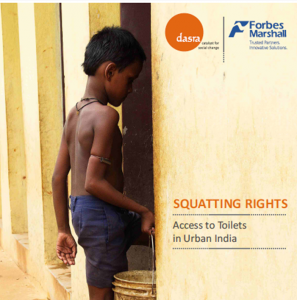Squatting Rights: The importance of urban sanitation in India, 2013.
“Growing slum populations and lack of toilets across Indian cities force over 50 million men, women and children to defecate in the open every day. The poor bear the worst consequences of this paucity in the form of ailing children, uneducated girls and unproductive adults, making these populations even more vulnerable, costing India 6.4% of its GDP.”
In a timely report, Dasra, an Indian strategic philanthropy foundation, studied the urban sanitation ecosystem, one of India’s most critical development challenges. In preparing the report, Dasra spoke to 25 experts from across government, corporates, non-profits, academia, social businesses and international development agencies. It also formed an Advisory Committee comprised of individuals from among the 25 experts to guide its research, report framework and recommendations. 
The report was funded by Forbes Marshall, a leader in the area of process efficiency and energy conservation for the process industry. “Rati Forbes, the director of Forbes Marshall is a keen supporter of the sanitation cause. She approached us to undertake a study on the sanitation sector – understand ground realities, challenges, role of stakeholders and top non profits doing significant work in the sector in India so as to direct more funding to one or more of these non profits,” says Pakzan Dastoor, an Advisory Research Associate at Dasra.
Dasra mapped more than 160 non-profits working in the urban sanitation sector and this list was brought down to 50 through a due diligence process, according to Pakzan. These 50 were interviewed over the phone, following which, the Dasra team spent two days with each of the 14 organisations finally selected, met with their senior management teams and visited the communities they worked in.
According to Dasra, non-profits are best placed to deliver impact at scale because of their proximity to the poorest communities and their ability to liaise with key stakeholders such as government and development agencies. It recommends that “philanthropists fund non-profits that are training stakeholders, enabling behaviour change for hygiene education and influencing government as these are the three most scalable and high-impact interventions undertaken to provide access to sanitation in urban India”, according to Pakzan.
While rural sanitation is adequately researched and funded, urban sanitation is yet to see that kind of attention, says Pakzan. “However, the growing influx of rural populations in Indian cities, lack of adequate infrastructure coupled with historical neglect of the issue at the policy level, make urban sanitation significantly more urgent,” she adds. The report contains some glaring numbers that emphasize the importance of investing in this area. According to the report, it is estimated that 55 percent of Indian do not have access to any kind of toilet and that 60 percent of the world that openly defecates, lives in India. Moreover, while developing countries need to spend at least 1 percent of their GDP on sanitation to meet minimum Millennium Development Goals, India spends only 0.45 percent. Even more disturbing is the fact that 1,600 children in India die every day due to diseases related to poor sanitation.
Following its study, Dasra recommends five cornerstones to tackle the problem of insufficient urban sanitation facilities in the country. These include:
- Developing a gendered approach: sanitation projects designed will full participation from women are five to seven times more successful than those that focus only on men.
- Improving hygiene: the most affordable and effective way to promote hygiene is by educating communities about the benefits of simple hygiene.
- Fostering champions within government: it is important to identify and foster champions for sanitation within all levels of the government who will enable favourable policy environments, reduce red tape and drive the sanitation agenda.
- Nurturing community ownership: the Indian government has employed a supply-driven approach to sanitation and that often neglects the needs of communities. There is a need to shift to a community-based approach.
- Customising solutions and creating standards: it is important to customise interventions in accordance with the unique features of slums and communities.
In an interesting approach to funding, each of Dasra’s reports is linked to Dasra Giving Circle, a group of ten philanthropists who pool a total amount of INR30 million (US$553,000). By way of vote, these philanthropists decide on one organisation from the ones profiled in the report to give that funding too. Pakzan says the organisation is given that funding over three years to scale its programme. In addition, the foundation provides capacity-building support to the selected organisation over the three years. Dasra is currently putting together a Giving Circle for the Squatting Rights report.






{ 1 comment… read it below or add one }
India is reported to be an economically emerging force and yet we have this deplorable situation. The bottom line is that the country is totally outmoded in it´s structure relying on thought patterns not suited to the 21st C. It may have economic growth but at what cost in human suffering. Until new thought forms based on real human needs arise the situation will continue to deteriorate.